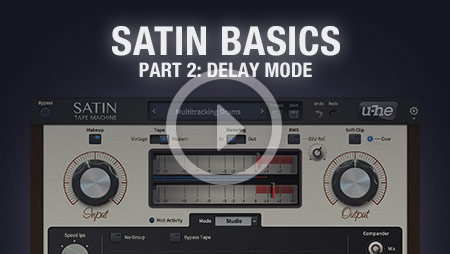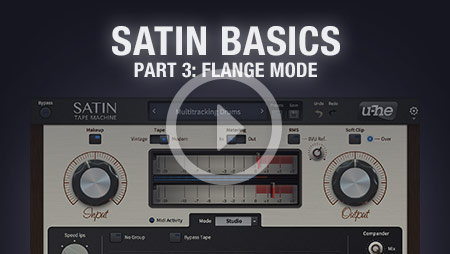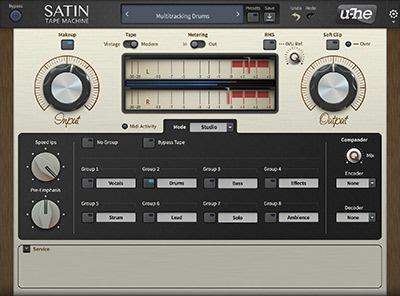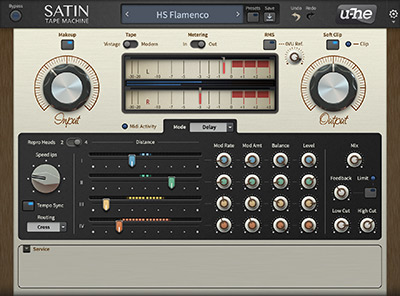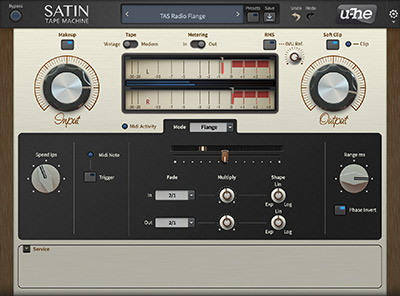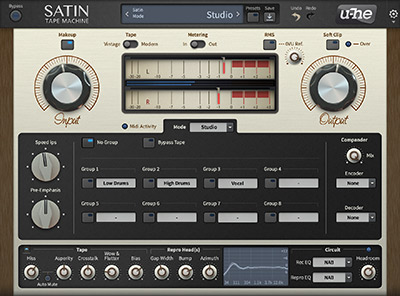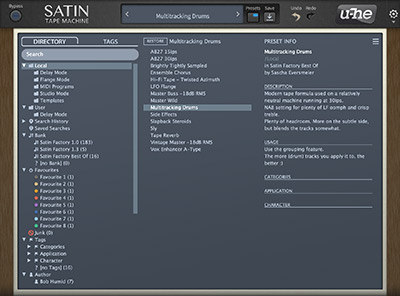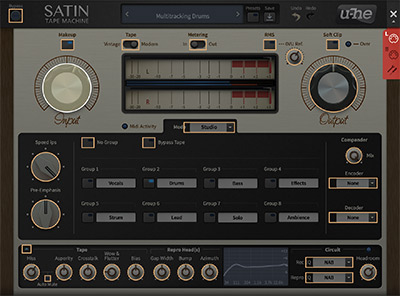

Tape simulation
Satin: Luscious tape machine
Nothing else quite sounds like tape. Satin puts the legacy of tape recording in your hands: from top-of-the-line multi-track consoles to humble cassette decks. All the good (saturation, transient smoothing, compression) as well as the bad (noise modulation, flutter, hiss) qualities are under your control. Construct your (im)perfect tape machine.
Satin in the spotlight…
Hover over the dots  to learn about Satin’s features
to learn about Satin’s features

- Lush analogue tape sound
- Includes historical developments in tape technology
- Control up to 8 instances of Satin at once using the Group panel
- 5 popular noise reduction encoder / decoder models
- Service panel: Controls for hiss, wow and flutter, bias, head gap, azimuth, saturation, high frequency compression and more
- Modern or vintage tape material
- Internal sample rate up to 384kHz
- 5 circuit models for recording and reproduction EQs
- Stereo delay mode (2 or 4 heads) with multiple-mono, cross or ping-pong routing
- Tape flange mode with classic through-zero flanging
- Adjustable tape speed from 1.87 to 30ips
- Pre-emphasis and soft clipping options
- Preset browser with search functions
- NKS FX compatible
- Resizable UI from 70% to 200%
- Skinnable UI
- 120+ factory presets
Sights and sounds
- Videos
- Screenshots
- Demo Tracks
Power to Fly
Power to Fly is a short demo of a rock song, courtesy of Blacky Schwarz-Ruszczynski, featuring Marian Gold (of Alphaville) on vocals.Read details about how we used Satin.
Metal
Heavy metal song courtesy of Blacky Schwarz-Ruszczynski, featuring Marian Gold (of Alphaville) on vocals.Read details about how we used Satin.
Drum'n'Bass
An atmospheric Drum'n'Bass roller. Satin adds strong colouring on all main elements, and is also responsible for all delay effects.Created by SpeaK
CLOSE ![]()
Rock example
Power to Fly was recorded in Logic and mixed in Samplitude. It consists of 21 tracks, five busses and fifteen instances of Satin:
- Tape delay effect on the lead vocals
- A-Type encoding on the backing vocals to add ‘freshness’
- On the drums
- On the master
All other instances are set up as a multi-track entity, using Satin’s Group feature.
Drum bus
In these snippets, the chorus part of the song is soloed. The multi-track group on the individual channels is bypassed, only the Satin instance on the drums remains active. These examples show how saturation and the overall texture change with higher input gain and different kinds of equalization.
All examples use the Vintage tape setting and 15ips Tape Speed. The audio is separated into four sections: Bypass, +6dB, +12dB, +18dB.
Drums - flat
No EQ, both Rec EQ and Repro EQ are set to Flat.The massive high frequency smear and loss of any transients should be clearly audible. But with moderate gain, Flat can be the right choice for taming harsh peaks and making everything round and soft.
Drums - IEC 15
IEC 15 for Rec & Repro EQ setting.Drums - NAB
NAB for Rec & Repro EQ setting.Listen to how NAB adds more saturation on the bass due to the low-shelf boost in the recording EQ. Note that NAB also preserves more high frequency content.
Vocal delay
This example demonstrates how Satin can be used as a traditional 4-head tape delay, where all the tiny imperfections and complexities add up to an organic ‘vintage’ vibe:
Lead vocal - Delay
Lead vocal. First without, then with delay.Compander tricks
Some noise-reduction systems were often mis-used by running the audio through the encoder circuit only, omitting decoding. Especially the A-Type systems gained popularity because they could add some pleasantly ‘airy’ compression. A nice exciter-type sound was possible when the lower two of the four frequency bands were bypassed by modifying the Cat 22 circuit board. This modification is also available in Satin.
Backing vocal - Delay
Backing vocal. First bypassed, then through Satin’s A-Type Mod encoder.If you are curious about how the regular Type-A sounds on the drums, check this one out: Bypass, Encoder, Decoder, Encoder & Decoder.
Drums - Type-A
Type-A encoding and decoding on the drums. CLOSE ![]()
Metal example
This heavy metal song is courtesy of Blacky Schwarz-Ruszczynski, featuring Marian Gold (of Alphaville) on vocals. It consists of thirteen tracks using Satin’s Modern tape setting and a Vintage tape setting on the master bus.
The lead vocals and solo guitar are sent through an additional instance of Satin in Delay mode to give them more width. Presswerk and Samplitude’s eFX Gate and Reverb were used on drums, vocals and guitars.
Metal (dry)
This is the dry mix without Satin.Metal (final)
Here is the mix with all Satins active.Once reserved for major studios, digital recording has become widespread. It offers pristine sound and comfortable editing at a fraction of the cost of multitrack tape. Despite all the advantages, however, digital audio can easily sound too clean and impersonal. So musicians, producers and audio engineers have turned to traditional analogue tools to bring some life back into overly clinical recordings. A world of non-linear behaviours, distortion, saturation and much more arises during tape recording and playback. Bringing these coveted characteristics of magnetic tape into the digital realm, in unprecedented quality—this is what Satin is all about.
Features
The sound
That tape sound depends on interaction between the various parts of a tape machine. Each contributes in one way or another—enhancing, reducing, combining—to generate the final sound.
Satin models individual components and lets them interact in the same way. For maximum flexibility in sound shaping, Satin is a toolkit of alternative parts, not an emulation of a single machine. Build your own custom tape unit. The perfect final sheen for your mixdown, or “glue” multiple drum tracks together, decode old NR-encoded cassette tape, or misuse Satin for extreme effects.
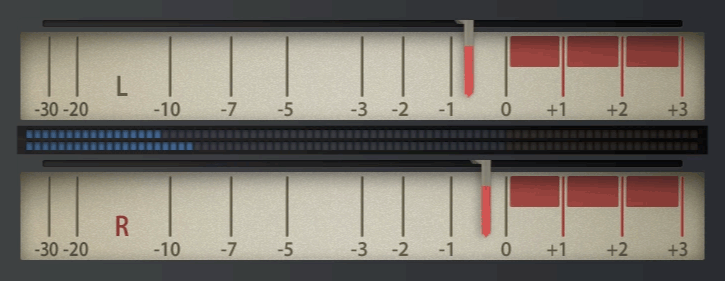
Satin's VU meters
Delay and flange
After developing the components for a tape machine toolkit, our minds turned other popular tape-based machines. Delay and flange immediately jumped to mind.
- Delay
- Flange

Delay panel with 4 repro heads
Delay mode lets you construct your own tape delay machine rather than emulate any specific model. A few clicks and you will be deep in echo in no time. Choose between two or four “tape heads”, adjust tape speed, select tape material, turn up the feedback, select signal routing, add some filtering. You can add motion to each individual “tape head” for a more organic feel. Tweak the Service Panel options and give your sound the characteristic shimmer of a classic tape echo.

Flange panel
Flange mode emulates the special technique of running identical recordings on two tape machines, then lightly pressing a finger on the reels to move the recordings in and out of phase. It was a skill that required patience and light touch. Luckily, Satin now makes it much easier and faster, all at the press of a button. For longer flanging effects or more precise control you can use the slider, either manually or automated.
In service
Imagine opening up a tape machine, peeking “under the hood” and tinkering with the parts. That is what service technicians used to do, and it is what the Service Panel in Satin is for. It gives you detailed control over some of the more esoteric and characterful elements.
In the Tape section are perhaps the more readily identifiable attributes of tape recording: hiss, asperity, wow & flutter, crosstalk and bias. Dial in a little of each for a retro vibe or “glue”. Dial in the extreme settings and you can end up with the sound of poor quality tape left in someone’s basement far too long.

Service Panel
The Repro Head(s) parameters control the physical attributes of the tape heads. With Gap Width and Bump you can cut or boost certain frequencies and introduce resonances and fluctuations. Azimuth pushes the audio off-centre for interesting spatial effects, mimicking a skewed tape head.
Finally the Circuit section lets you change the inner EQ circuitry. Included are various industry standard EQ curves, should you want to mimic specific machines. But Satin goes a step further by allowing independent selection of the recording and reproduction EQ curves. Which you can abuse for weird processing effects, or to correct EQ errors in old recordings (see below).
Decoding
Selectable Compander and Circuit settings make Satin useful as a format converter.
If you have a tape recording with an unsuitable EQ, using Circuit’s independent RecEQ and ReproEQ selectors you can set a new target EQ curve and make changes. Similarly, Compander can handle audio recorded with specific noise reduction (NR) encodings. Just run it through Satin with Decoder set to match the known NR encoding type.

December 2016
2016 - Top ProductReleasetime

December 2016
2016 - Best ValueReleasetime

December 2013
2013 - Editor's ChoiceBeat
“If you’re in the market for the sound of tape without the hassle of owning a real tape machine, you won’t go far wrong with Satin.”
November 2013
“What's most impressive about Satin is how a little of it can go a long way.”
May 2014
Configuration
- Resizable GUI from 70% to 200%
- MIDI learn page and editable list
- Global preferences page
Modes
- Studio mode: Control up to 8 instances of Satin at once using the Group panel
- Stereo delay mode (2 or 4 heads) with multiple-mono, cross or ping-pong routing
- Tape flange mode with classic through-zero flanging
Service Panel
Controls for hiss, wow and flutter, bias, head gap, azimuth, saturation, high frequency compression and more
Circuit
5 circuit models for recording and reproduction EQs (separately selectable): Flat, IEC 7.5ips, IEC 15ips, NAB, AES 30ips
Tape Speed
Adjustable tape speed from 1.87 to 30ips
Noise Reduction
5 popular noise reduction encoder / decoder models
Tape Type
Modern or vintage tape material

Download the demo and enter your serial number to unlock the full version. The demo version emits crackling sound at irregular intervals.
Satin 1.3.3 (revision 15721)
Released March 27, 2024
Release notes
* About Linux: Before purchasing, please be aware the Linux versions of our plug-ins are still considered beta. While the plug-ins are stable, we are not able to provide the same level of support for these products as we do for the macOS and Windows versions. Support is provided via the Linux and u-he communities on our forum ![]() .
.
Requirements
![]() Mac OS X 10.10 or newer
Mac OS X 10.10 or newer
or
![]() Windows 7 or newer
Windows 7 or newer
or
![]() Linux
Linux
- Host software / DAW
- 1GB RAM, more recommended
- 1000 × 600 or larger display
- 35-95 MB free disk space
- Modern CPU required:
Windows/Linux: Intel Nehalem or newer, AMD Bulldozer or newer
Mac: Intel Nehalem or newer, Apple M1 - Linux: glibc version 2.28 or newer
Formats
Satin is not a standalone product, it requires host software. Satin is compatible with nearly all DAWs.
macOS:
CLAP, AUv2, VST2, VST3, AAX*
64-bit
Windows:
VST2, VST3
32-/64-bit
CLAP, AAX*
64-bit
* AAX requires Pro Tools 10.3.7 or later
![]()
This product is Native Instruments NKS-ready and compatible with Maschine and Komplete Kontrol hardware.
![]()
VST is a trademark of Steinberg Media Technologies GmbH, registered in Europe and other countries.
User Guides
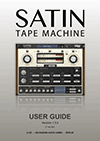
Downloads for Satin
Try the latest builds of Satin, which include improvements and bug fixes. Note: these are stable, but still beta versions.
Older Satin installers are in our release archive (for legacy systems).



